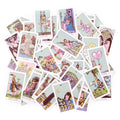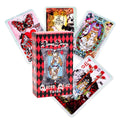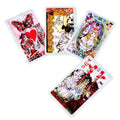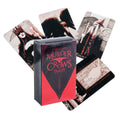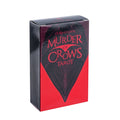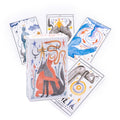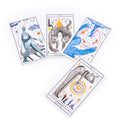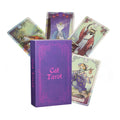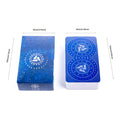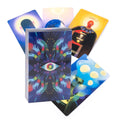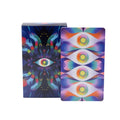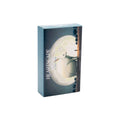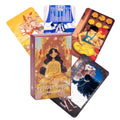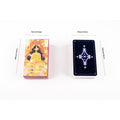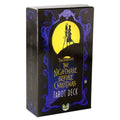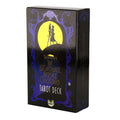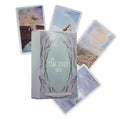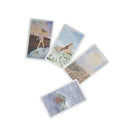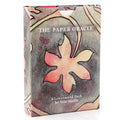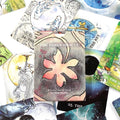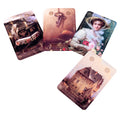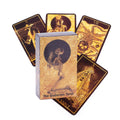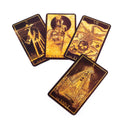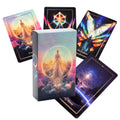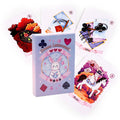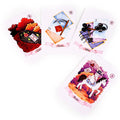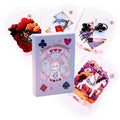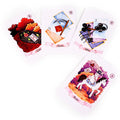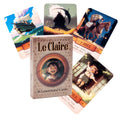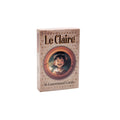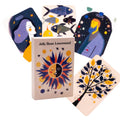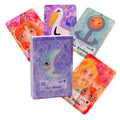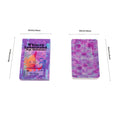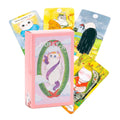Golden Art Nouveau Tarot Guidebook
GOLDEN ART NOUVEAU TAROT ONLINE GUIDEBOOK
The Art Nouveau movement arose in the late nineteenth and early twentieth centuries, a time when Europe was experiencing relative peace after decades of conflict. Gazing back at this period of optimism, we have named it la Belle Époque, the Beautiful Era. Chief among its beauties was Art Nouveau (New Art), a graceful decorative movement that spread like tendrils of a flowering vine throughout Europe and on to America. Translated to tarot, Art Nouveau brings sensual beauty to these timeless messages, allowing them speak directly to the heart.
HOW TO USE THE CARDS
A simple way to read the card is to draw three Arcana and place them on a single row.
- 1. Look at your past. Understand the road that brought you to the current moment. Understand the choices, the events, the causes.
- 2. Look at yourself. Understand your feelings, your fears, your hopes. Understand what you want and what you can’t accept.
- 3. Look forward. Understand the direction you are going. Understand if you need to change, or if you should stand as you are. Find a way to build a future that will make you grow and prosper.
3
MAJOR ARCANA
0 - The Fool. The Fool embarks upon the journey of life with a light heart and a spirit free of expectations. Every adventure he encounters along the path has the potential for joy. His faithful dog tries to warn him away from the cliff’s edge, but he is heedless of the danger. His very innocence may keep him from harm.
I - The Magician. The Magician calls upon the energy of the universe to bring his desires into manifestation. Whatever he imagines can and will come to pass. The wand in his right hand is a conduit for universal energy, and his other hand points to the earth, grounding the energy in reality As above, so below: divine and earthly creativity in perfect union.
II - The High Priestess. The High Priestess reveals secret knowledge to initiates who have earned that right. Ancient mysteries are contained within her scroll of wisdom. Her temple pillars are engraved with B and J for Boaz and Jachin, the qualities of duality: dark and light, endings and beginnings. Wisdom lies between these extremes.
III - The Empress. The Empress is the embodiment of Nature herself, the sustaining love of the earth offering its bounty. She nurtures us as a mother encourages her children to be all they can be. She is the source of life, abundance, and sensual pleasures. The Empress is crowned with stars, for her power is not just in her earthly gifts but in her feminine intuition and vision.
IV - The Emperor. The Emperor is the embodiment of civilization and its dominion over nature.
4
The orb in his left hand represents that dominion: it is the world which is his to command. The scepter in his right hand is his symbol of authority. He who holds the scepter is recognized as rightful leader who is deserving of respect.
V - The Hierophant. The Hierophant is the power of religious authority, dogma, tradition, and the laws of morality. The two supplicants kneeling before him seek his blessing and find comfort through confession and absolution. A true spiritual teacher will inspire self-forgiveness and a fresh start, free of the guilt and shame of the past.
VI - The Lovers. A woman and man stand together in the primal garden of bliss. The woman offers the fruit that dispels illusion; choosing to eat opens the garden gates and lets in the real world. This is the choice that marks the difference between mere infatuation and true love. The Lovers choose to know one another and to know themselves.
VII - The Chariot. A conquering hero stands in his chariot of victory, a great city behind him. Perhaps this is the city he has captured, or perhaps it is the city of his birth, awaiting his triumphant return. The mystical sphinxes that draw his chariot are at rest for the moment, awaiting his next command.
VIII - Strength. A lady stands with a magnificent golden lion, her hand trustfully near his massive teeth. She has no fear of this beast: the goodness of his heart is more powerful than his instinct to destroy. His natural impulses have been tamed by her trust. This is true strength: the courage to embrace the unfamiliar.
5
IX - The Hermit. On a snowy peak, a Hermit lifts his lamp of knowledge, shining it forth as a beacon from the heights. He has withdrawn from the noise of the world in search of spiritual understanding, without the distractions and opinions of others. The Hermit’s lamp shines through the darkness of ignorance to guide those who are ready to look within.
X - The Wheel of Fortune. With no beginning and no end, the Wheel of Fortune symbolizes the eternal cycles of fate. The stages of life, the seasons of the year, the phases of the moon—everything in our human experience is in a constant state of change. Four elemental beings represent lessons that life offers along the way, and the sphinx is a reminder that existence itself is the great cosmic riddle.
XI - Justice. Measuring all human deeds upon her golden scales, Justice restores the balance. Acts of injustice meet with their rightful consequences, and her sword of truth dispels illusion. She sees through any veil of self-deception in which you have swathed yourself. There is no need to fear her influence if your conscience is clear.
XII - The Hanged Man. Suspended from a gallows, the Hanged Man is visited by beatific visions. He is bound not as punishment, but to suspend him between the worlds and allow his consciousness to fly where it will. Grapevines twine upon the tree, a symbol of divine ecstasy. The Hanged Man has been overtaken by this ecstatic state and can only surrender to it.
XIII - Death. Clad in armor, Death rides forth across the countryside. His horse steps over the
6
body of a king, a bishop begs for mercy, a mother tries to shield her child from his gaze. Death comes for all, regardless of wealth or social station. Yet for all his fearsomeness, Death’s banner bears the mystic rose, symbol of rebirth, and in the distance a new day is dawning.
XIV - Temperance. An angel performs a mystical rite to restore spiritual harmony, pouring water from one cup to another. These are the waters of life, which flow from a common source to all parts of the universe. With one foot in the water and one on land, the angel symbolizes the integration of body and spirit.
XV - The Devil. A man and a woman are in bondage to their own lesser impulses, as much as they are captives of the Devil himself. The Devil entices the weak to chase temporal goals of wealth, lust, domination, and then enslaves them in hellish eternity. This card is a reminder to choose wisely and follow the pathways that lead toward the light.
XVI - The Tower. A blast from the heavens destroys a Tower that seemed unconquerable, its magnificent crown-like dome tumbling to the ground. Two people fall helplessly from the heights. The Tower was built with such a forbidding design that it imprisoned them in their own creation, with no easy exit. Seek liberation on your own, or the universe may give it to you in unexpected ways.
XVII - The Star. A tranquil landscape is bathed in the light of seven stars surrounding a single large star. These are the Pleiades, the sister stars who sing in universal harmony, with a greater star that
7
represents all celestial energies. Each of us holds within our souls this light of hope, faith, and infinite trust.
XVIII - The Moon. Two wolves howl their instinctual greeting to the Moon. Drawn by the tidal pull, a crayfish crawls out of a pool, symbolizing submerged fears and impulses that arise from the depths of the unconscious. The mystery of the night calls forth visions, imaginings, and dreams. Heed all signs and portents.
XIX - The Sun. The benevolent Sun shines upon a jubilant naked child holding a red banner aloft, symbolic of the soul’s liberation. All-powerful life force radiates over the scene, and sunflowers turn their faces to follow the glorious Sun child. Considered the most positive card in the deck, the Sun card speaks of goodness, growth, delight, and joy
XX - Judgment. A mighty archangel blows his hom to call the dead to rise. The mortal souls below are called to face their life deeds. This is a time of rebirth, for the slate is wiped clean from this point on. Those who stand up to frank assessment of their character can move forward. Those who live in denial are doomed to repeat the old life lessons again and again.
XXI - The World. A laurel wreath delineates a portal in time and space, surrounded by elemental creatures. Emerging from the wreath is a cosmic dancer, with crystal wands that channel pure energy from heaven to earth. What has been undertaken is complete. Step through into the new life that awaits you.
8
CUPS
The Cups cards represent the element of Water. This is the element of emotions, relationships, intuition, and love.
Ace of Cups. The Ace of Cups signifies that which is dearest to your heart. It is the Grail, the symbol of the soul’s deepest joy. The dove of communion and the water lilies of peace symbolize the integration of emotion with a vision of life’s purpose.
Two of Cups. When two people experience true affinity of heart and mind, it is as if an angelic presence blesses them both. The winged lion symbolizes the courage to be vulnerable with another person, to share your secrets and your dreams. Given time and trust, this love may deepen into commitment.
Three of Cups. Three women dance together in spontaneous delight, full of happiness made more joyful by sharing it with friends. The pumpkins symbolize a time of ripeness and thanksgiving. Your relationships ripen and grow when you celebrate them.
Four of Cups. A man sits in an attitude of despondency and malcontent. Three cups sit before him, all rejected, and another is offered to him from a cloud. The fourth cup is also refused. The possibility of love and happiness is rejected.
Five of Cups. A man faces a town in the distance, his posture suggesting regret, as if he has been exiled from a place he once loved. The cups at his feet also speak of failure—three are spilled, though two remain. The elixir of life’s experience has proven
9
disappointing, but what remains holds the potential of future happiness.
Six of Cups. Two children in a sheltered garden space enjoy the fragrance of fresh flowers. They symbolize the safety and innocence of childhood, when tender feelings are sheltered from the harsh world. You may need some of this sheltering now.
Seven of Cups. A man stands amazed before a kaleidoscope of visions emerging from seven cups. Each offers a different focus for his next step on life’s journey, but which is the right one? If all choices seem equally appealing, perhaps it is not time to choose.
Eight of Cups. A cloaked figure with a walking staff turns his back on eight cups and starts out across a rugged landscape, under a waning moon. What was once satisfying no longer satisfies. There is another call so compelling that it must be followed. Move forward with the knowledge that you are on the right path.
Nine of Cups. A well-to-do merchant sits before a table with nine cups. He has achieved everything he wished to attain. It remains to be seen if his emotional needs will be as fulfilled as his material wants. The universe is working in your favor now, so be careful what you wish for.
Ten of Cups. A happy family welcomes a rainbow vision that blesses their home. A trouble or struggle is fading away, and the happiness that follows is more intense because of it, as a rainbow follows the storm. Home, health, love, prosperity—all will benefit now.
10
Page of Cups. This page is a sensitive youth with little experience in the real world of relationships. He prefers to keep things at a superficial or casual level while he is learning how to trust. The fish symbolizes the potential for spiritual growth and greater depths in time.
Knight of Cups. With his chalice lifted in salute, this knight represents the approach of love and romance. The wings on his helm and heels symbolize the swiftness of his advances, and it can also signify that he may leave as swiftly as he came. Test his heart for trueness before you surrender your own. Queen of Cups. This queen brings grace and sensuality to everything she touches, and she smoothes over rough situations with her gentle kindness. She is highly intuitive and makes decisions based upon heart rather than head. Although she may retreat into her dreamy world of imagination, she is a deeply committed mate once her heart is won.
King of Cups. This king is a steady presence in a turbulent sea. Fatherly and kind, he can be a source of emotional support, helpful advice, and comforting strength in times of trouble. He is a peacemaker who will always listen with his heart as well as his mind. He keeps himself in balance by practicing detached compassion.
PENTACLES
The Pentacles cards represent the element of Earth. This is the element of work, the body and the senses, money, home, and all tangible things.
11
Ace of Pentacles. The Ace of Pentacles signifies the beginning of a fruitful period, in which anything you undertake will add to your well-being. A lily-bordered path leads through an archway and out to the wider world, symbolizing opportunity, including increased wealth.
Two of Pentacles. A man stands on the shore juggling two pentacles back and forth in a pattern of infinity He must take care to keep his footing upon the shifting sands. As you balance multiple tasks, be sure you are giving adequate attention to everything that is your responsibility.
Three of Pentacles. Building a cathedral, the craftsman, clergyman, and architect each undertakes the role for which he is best suited. When people bring their skills together toward a common goal, they achieve far more than any of them could create on their own.
Four of Pentacles. A wealthy nobleman sits alone outside the castle walls, clutching pentacles in a fearful embrace. He has no room in his heart for others; money is his foundation and his primary love. Without connection to humanity, nothing will ever truly satisfy him.
Five of Pentacles. Two beggars struggle through a blizzard, wounded and miserable in body and soul. And yet, warmth, light, and sanctuary are very close at hand. Their prayers will be answered, but only when they can break free of self-pity.
Six of Pentacles. A wealthy merchant distributes coins to beggars at his feet, but no warmth of human kindness is behind the act of largesse. The scales he holds symbolize some balance that
12
will be owed, rather than alms treely and generously given.
Seven of Pentacles. A gardener leans upon his spade, taking a moment of contemplation as he gazes as his crop. His earthly path is made up of mundane moments—daily work tasks, routines, and small steps toward larger goals. Patient and constant effort will bring great abundance in its proper time.
Eight of Pentacles. A dedicated artisan practices and perfects his craft. The acquisition of skills is not accomplished overnight. Perseverance and commitment to excellence lead to success. He may experience some isolation in honoring his work, but it will be worth the sacrifice in time.
Nine of Pentacles. A noblewoman has created a garden sanctuary for herself where she can contemplate the richness of her inner life. She is content to dwell in solitude with only a bird as companion, for she is at peace with herself. She chooses independence as her reward for the sacrifice of society. Ten of Pentacles. Three generations gather in the courtyard of their ancestral home. The elder patriarch has given the responsibilities of the household over to his son, but his wisdom is still revered. The young ones are being taught to respect the family’s legacy of tradition, honor, and continuity.
Page of Pentacles. This page is a young person who offers assistance in practical tasks and undertakings. His loyalty and trustworthiness are unsurpassed. The more responsibility you can give him, the better for both of you. Mutual fruitfulness will be the reward.
13
Knight of Pentacles. This knight is not a risk-taker, but he makes up in determination what he may lack in boldness. Given a task that benefits others, not just himself, he will perform it with care and diligence. He is a good choice to lead a team effort, for he does not seek personal glory.
Queen of Pentacles. This queen is the practical mother who knows best. She offers her advice freely and it is always worth taking. She can find solutions to problems that may seem insurmountable to others. Her connection to nature is the source of her strength, which she generously shares with those she loves and protects.
King of Pentacles. This king has the tenacity of a bull combined with shrewd practicality. He sees the long view and builds for the future, for his primary purpose is stability. When he agrees to help you, success is assured. This may include a substantial gift or loan that brings a long-held dream into reality
WANDS
The Wands cards represent the element of Fire. This is the dement of action, will, forceful energy, transformation, and ambition.
Ace of Wands. The Ace of Wands signifies a creative impulse rising within you. Any step you take in any direction will put you on the path to success. The time for action has arrived.
Two of Wands. From the heights of his establishment, a gentleman looks out the landscape below. In one hand he grasps a wand and the other holds
14
a globe—together they symbolize working his will in the world. His powers have not yet been tested, but he is ready for whatever challenges may come. Three of Wands. A nobleman stands on a promontory watching his ships sail out to sea while he remains behind. While he may long to go with them and seek adventures himself, his merchant sailors and explorers will undertake his quests for him for the time being. He knows that for the present, his place is here.
Four of Wands. Citizens of the city prepare for a festival to mark a time of great joy. Such festivals are vital to the human spirit, for they affirm that life is more than just day-to-day routine. When peace and harmony return after a time of trouble, pause to celebrate. It is important to create ceremonies to mark significant events.
Five of Wands. These warriors are comrades at arms, brothers with a common cause, and their mock battle was only meant as practice for when they face an actual foe. Their tempers have got the better of them—something has tipped the balance from fun to ferocity. It may take a cooler head to intervene and restore the peace.
Six of Wands. A knight returns home from his quest, bearing the laurel wreath of victory. There is no false modesty here—he knows his success is deserved—and those who follow him are also respected and share in his glory. As he progresses upward in his career, he will remember those who helped him get there.
Seven of Wands. Beset by foes, a young man stands in a posture of courage and strength.
15
Though he is outnumbered, he still has the upper ground, literally and symbolically. He welcomes the challenge to prove himself. Even against such odds, his confidence shines.
Eight of Wands. A flight of wands rushes to earth, disturbing an otherwise tranquil landscape. Is battle commencing? Is it a portent of some message to come? Something is changing, for better or worse. Wait for further information before proceeding or responding.
Nine of Wands. A battle-wearied man stands before a phalanx of wands, gathered in defense against the next battle to come. All that remains now is to gather the inner strength to face whatever presents itself. His position is secure and only his own self-doubt can shake it.
Ten of Wands. Overburdened with an impossible load, the man cannot hope to successfully carry all these wands to his destination. A wise person knows when too much has been taken on. Don’t weigh yourself down with so many tasks and projects that none can be done well. Hand over some of your responsibilities; do not make yourself a martyr.
Page of Wands. This page has creative potential but has not quite decided yet where to put his energy. Inclined to bursts of enthusiasm rather than a sustained effort toward a goal, he will need guidance to fully realize his gifts and use them wisely.
Knight of Wands. Bold and bound for glory, this knight may rush in where angels fear to tread. He is more susceptible to failure than those who never take a chance, and yet, fortune seems to follow
16
him and keep him from true harm. He will champion any righteous cause and pursue any path that promises adventure.
Queen of Wands. This queen combines intuition with practicality to spark a creative blaze that warms all who know her. She brings passion to any undertaking and inspires others to strive for excellence. When she focuses her will on a purpose, it grows with astonishing speed, like the sunflower that is her emblem.
King of Wands. This king is decisive and confident, with the impressive demeanor of a born leader. He does not hesitate to take action against injustice or oppression, and he inspires others to stand up for their own rights. You can expect his support and strength in times of need, but present a clear plan if you want his help.
SWORDS
The Swords cards represent the dement of Air. This is the dement of communication, conflict, the intellect, clarity, and challenges.
Ace of Swords. The Ace of Swords signifies an emerging understanding and clarity of thought. The sword of light and truth rises through the crown of worldly attainment, symbolizing a more noble purpose than mere wealth or fame. Invoke your higher self and use your intelligence.
Two of Swords. A blindfolded lady has retreated o a secluded spot by the sea. The swords she holds yarn off any who would approach and break her concentration. While her body is still and her sens
17
es are cut off from distractions, her thoughts flow freely, seeking the answers she needs.
Three of Swords. Some suffering can only be moved through, not avoided or denied. Only the heart can know when it is time to pull the swords out and begin again. Let your tears fall and give sorrow its due. Consider carefully before you assign any blame; it is unlikely that you are thinking clearly.
Four of Swords. The effigy of a knight adorns his tomb, and his swords are hung nearby in honor of a lifetime of victorious endeavor. He is at rest now and will fight no more. This scene is a symbol of strife that is permanently ended. The knight is honorably released from the past and can go in peace.
Five of Swords. A battle is over, and the winning warrior gathers up his spoils. The defeated men must decide their next step—to join with the former enemy, to journey back home, to strike out alone. No war lasts forever, and when it is over, how you deal with it determines your character.
Six of Swords. A ferryman transports a cloaked traveler and child across choppy water toward a farther shore. The boat is full of swords, signifying that the refugees are bringing their troubles with them. It will take time to heal body and spirit in the new land.
Seven of Swords. A thieving warrior sneaks into the enemy’s camp and steals their weapons. He does not care about honor or righteous battle; he pursues victory at any price. Taking such a sly and indirect strategic position throws everything into
18
potential chaos. The danger to all has been increased by this rash action.
Eight of Swords. A lady has been bound in isolation as a punishment for some misdeed. It appears that she has accepted her fate—her legs are not tied, and she could easily slip from the loose bonds that confine her. Someone who believes they are a victim will always find others who make it so.
Nine of Swords. A man awakens from a violent nightmare. He starts from the bed, lost in terror and despair. This is the dark night of the soul, when all seems lost. A mind caught in hopelessness cannot imagine the coming of the dawn, but it will always come.
Ten of Swords. The battle is over. It is time to bury the dead, heal the wounded, and make peace. This is a time of sorrow as well as relief. The harshness and violence of the conflict will not be swept away soon. All that can be done is to pick up the pieces and carry on.
Page of Swords. This page is an impetuous young person who needs a firm hand to avoid reckless behavior. He needs to learn to think things through before taking action. He is open to new ideas and receptive to instruction, though emotional entanglements may feel like a distraction from his ambitions. Knight of Swords. This knight moves aggressively toward what he wants, and he may consider other people as obstacles in his path. He has no respect for the weak—either deal with him forcefully or get out of his way. The ruthless edge of his sword cuts both ways, for there is rarely true peace in his quarrelsome heart.
19
Queen of Swords. This queen keeps her distance and does not easily welcome intimacy. Those who are worthy of her company must respect her independence and intelligence. She sees all sides of a situation clearly, which allows her to manipulate it to her advantage. Her cool detachment may seem heartless, but those few she loves are loved fiercely. King of Swords. This king is a brilliant strategist and a formidable adversary. His sense of timing allows him to succeed where more impetuous opponents fail. Though it may seem as if he is passive in his quiet watchfulness, never underestimate him. He has hidden weapons and will strike when the moment is most advantageous for his plans.

